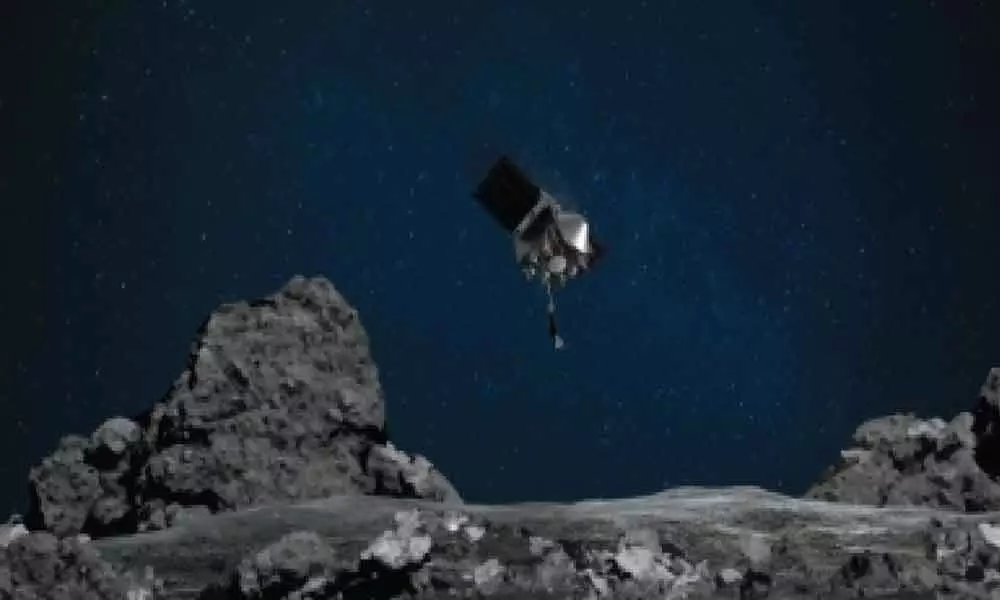Live
- Strict measures in Place for AP SSC examinations
- Kancha Gachibowli land: Activists launch campaign to preserve urban lung space
- GHMC proposes euthanasia for aggressive strays
- Over 6 lakh Olive Ridleys turn up at Gahirmatha
- Two women journos held for ‘defaming’ CM
- 25 lakh ‘Lakhpati Didis’ in next 5 years: Patra
- Villagers come together against illegal mining
- NALCO holds Customers’ Meet
- Notorious criminal injured in encounter
- Food safety officials inspect mangoes at Mozamjahi mkt
NASA spacecraft makes 1st touchdown on asteroid Bennu


NASA spacecraft makes 1st touchdown on asteroid Bennu
After over a decade of planning, a NASA spacecraft made history after it successfully touched an asteroid to collect dust and pebbles from its surface.
Washington: After over a decade of planning, a NASA spacecraft made history after it successfully touched an asteroid to collect dust and pebbles from its surface.
The Origins, Spectral Interpretation, Resource Identification, Security, Regolith Explorer (OSIRIS-REx) spacecraft unfurled its robotic arm on Tuesday in an attempt to collect the sample from asteroid Bennu, which is currently more than 321 million kilometres from Earth, NASA said.
"Preliminary data show that today's sample collection event went as planned. More details to come once all the data from the event are downlinked to Earth," NASA's OSIRIS-REx mission said in a tweet.
"After over a decade of planning, the team is overjoyed at the success of today's sampling attempt," Dante Lauretta, OSIRIS-REx principal investigator at the University of Arizona in Tucson, said in a statement.
However, it will take about a week for the OSIRIS-REx team to confirm how much sample the spacecraft collected.
Bennu offers scientists a window into the early solar system as it was first taking shape billions of years ago and flinging ingredients that could have helped seed life on Earth.
If Tuesday's sample collection event, known as "Touch-And-Go" (TAG), provided enough of a sample, mission teams will command the spacecraft to begin stowing the precious primordial cargo to begin its journey back to Earth in March 2021.
Otherwise, they will prepare for another attempt in January.
"This amazing first for NASA demonstrates how an incredible team from across the country came together and persevered through incredible challenges to expand the boundaries of knowledge," said NASA Administrator Jim Bridenstine.
"Our industry, academic, and international partners have made it possible to hold a piece of the most ancient solar system in our hands."
At 1.50 p.m. EDT, OSIRIS-REx fired its thrusters to nudge itself out of orbit around Bennu. It extended the shoulder, then elbow, then wrist of its 3.35-metre sampling arm, known as the Touch-And-Go Sample Acquisition Mechanism (TAGSAM), and transited across Bennu while descending about 805 metre toward the surface.
After a four-hour descent, at an altitude of approximately 125 metres, the spacecraft executed the "Checkpoint" burn, the first of two maneuvers to allow it to precisely target the sample collection site, known as "Nightingale."
Ten minutes later, the spacecraft fired its thrusters for the second "Matchpoint" burn to slow its descent and match the asteroid's rotation at the time of contact.
It then continued a treacherous, 11-minute coast past a boulder the size of a two-story building, nicknamed "Mount Doom," to touch down in a clear spot in a crater on Bennu's northern hemisphere.
The size of a small parking lot, the site Nightingale site is one of the few relatively clear spots on this unexpectedly boulder-covered space rock, NASA said.
The sample collected by the spacecraft will return to Earth in 2023.

© 2025 Hyderabad Media House Limited/The Hans India. All rights reserved. Powered by hocalwire.com






